Predict customer churn using Zia
One of the biggest ongoing challenges businesses face these days is customer churn. It means your customers are discontinuing their transactions with you or, in other words, withdrawing from your business. This is a threat for any thriving business, as it can negatively affect your business, financially and operationally.
When you think about customer churn, there are two angles to it—
- being aware of churn after it has occurred and making up for it,
- and not being aware of it at all.
Both are equally dangerous and will cost you dearly.
For instance, once you know that X number of customers have left you, your immediate action may be to begin fresh efforts to acquire new customers to compensate for the ones you lost. However, this could cost you a lot more efforts, time and money than your efforts for retention.

According to a research on loyal customer relationships conducted by Bain & Company, the cost of acquiring and onboarding a new customer is 5 times more costly than retaining an existing one.
Therefore, this retrospective observation and action will do no good for any expanding business.
The second possibility is even more dangerous — you don't even know which customers have churned or when.
In this article collated by huffpost , Esteban Kolsky observes only about 1 in 26 unhappy customers complain about their bad experiences, the rest churn out from a business silently.
So, either you are busy compensating for lost customers by investing hugely in lead acquisition. Or worse, you are unaware of silent churn until it's too late.
In either case, the only effective solution to mitigate the problem of customer churn is to figure out how to proactively recognize churn before it actually happens. You need a facility to identify your churning customers as they display their churning behavior. Only when you are aware which of your customers are churning and when they are churning, can you address them with the best of measures.
And, this is where Zia's Churn prediction will help you.
Zia—Zoho CRM's intelligent assistant—is designed to study customer behavior, analyze the pattern and frequency of customer transactions, and come up with real-time predictions on the churn probability . Because Zia could spot a churning customer right at the moment, you can be aware of all the shortcomings and prevent further customer decay.
Zia's churn prediction
Zia's capability to predict customer churn involves determining whether a customer will leave your business and identifying the specific product or service they are losing interest in. It doesn't just stop there. Zia will also lists out the reasons that are inducing the churn, as well as the reasons that are preventing the churn from happening for users to get more insights.
On the churn prediction widget, you can see the churn probability as a numerical score shown on a customer record. The higher the score, the higher the probability of churn.
Upon clicking Know More, a pop-up will present detailed reasons behind the customer's likelihood of churning.
The pop-up displays the proportionality of each reason's contribution to the prediction score. For instance, if poor service quality, competitive offers from competitors, and billing issues are the main reasons a customer might churn—the churn-inducing factors—the pop-up will indicate how much each of these factors has contributed to the predicted score. This adds a layer of transparency and enables you to understand the why behind churn predictions.
On the other hand, the churn-preventing factors list the factors that are keeping the customer engaged and avoiding or delaying possible churn, along with how much value each factor holds.
These reasons will be determined by considering all customer module touch points, including data points from related modules and VOC data.
Availability
Zia Churn prediction is available only for the following kinds of organizations:
- Organizations in Enterprise and Ultimate editions with 20 user licenses or more.
- Organizations in the US, EU, IN, CN, and AU DCs.

Permission required
There are two types of permissions available for the Zia Prediction feature in Zoho CRM: Manage configuration and view results. These permissions can be enabled for other users by CRM administrators.
- Manage configuration : Only those who have this permission enabled for their profile can create, edit, view, enable, disable, or delete a rule.
- View results : Users with this permission can only view the prediction results.
Note : By default, the view results permission is enabled for all profiles when Zia Prediction is toggled on. The manage configuration permission must be enabled manually.
Business scenarios
Zia analyzes your customer records for their churn possibility based on the configuration you set up. Irrespective of your revenue model—subscription-based or not—Zia will adapt its prediction to assess the churn percentage. 
As you can see, for subscription-based customer record, Zia will display the churn score, product/ service they have subscribed to that is churning and for the record that is not subscription-based, Zia just displays the churn score, as the product cannot be ascertained like the former.
Let's look at some examples:
Predicting churn in a telecom provider
(Meta: Churn prediction in a subscription model)
Zylker Communications is a telecom provider that provides phone, internet, and satellite connections. It offers two payment modes—prepaid and postpaid—to cater for different types of customers. Zylker's revenue model is therefore recurrent in that customers have to subscribe to enjoy its services. While one might assume that having a subscription indicates loyalty to the business, Zylker is losing a considerable number of customers each month. Zylker's goal is to identify which product is getting churned the most and to identify it as early as possible. This is where Zia's Churn Prediction can help. By analyzing the customer base and their transaction schedule, Zia spots records that are on the verge of churning and rates their churn probability on the record details page.
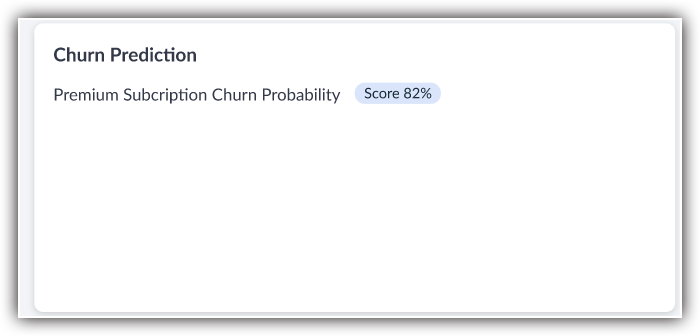
Zylker can thereafter take steps to recover the churning customers using automation like workflow rules. 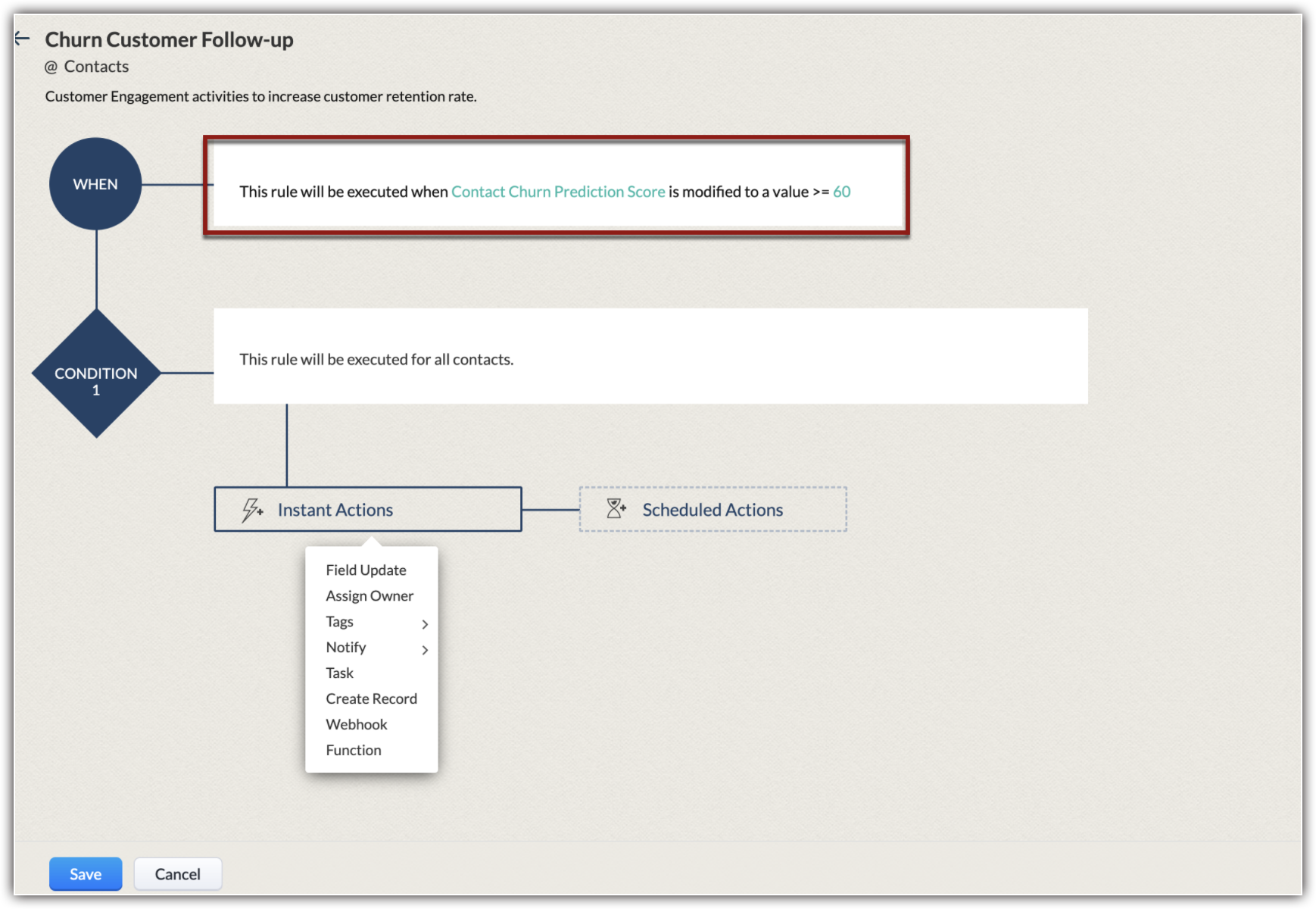
Predicting churn in a retail store
(Meta: Churn prediction in a non-recurrent revenue model)
Zarrow is an international online retail store that sells all kinds of products and they are looking to identify churning customers before they decay any further. However, for a business whose revenue model is not subscription-based, each transaction becomes a new business opportunity. Also, when the customer interaction is not recurrent, it becomes difficult to track their churn. Regardless, Zia can help address this need as much as possible. With the definition of active and churned customers configured and with its ability to analyze customers' historical transactions, it will compute their current behavior to identify churn probability.
Zia will offer an overall churn probability for customers on an ad-hoc basis wherever applicable. 
Click here to view the usability of these scores in your daily CRM activities.
Configure Zia Churn Prediction
For Zia to start predicting churn, you need to educate Zia on the information regarding your customers and their payment modes. In just about four steps, you can configure the prediction settings and Zia will be up to compare and compute churn in your business.
Step 1: Specify a customer information.
Step 2: Specify a payment module.
Step 3: Define successful payment criteria.
Step 4: Define customer churn for Zia.
Step 1: Configure customer information
The first step is to teach Zia where to fetch your customer information. Churn predictions will be displayed for the records in this module. It can be a standard module or any custom module in your CRM.
Specify criteria: You can apply prediction for all records in the customer module or only for specific records that satisfy the criteria.
For example:
- Imagine you have a quarterly revenue goal and you'd like to be informed about any shortcomings that could affect your revenue. You can enable churn prediction for all records in your module and be vigilant to address any churn that might occur.
- If you'd like to know how many of your loyal customers are about to churn, you can set criteria based on their churn scores.
Step 2: Specify a payment module
After teaching Zia who the customers are, it's time to show Zia where their transaction information is stored in CRM. Information from this module will be used to learn their payment patterns. It can be any standard or custom module in CRM. Modules created as a result of an integration will not be listed. 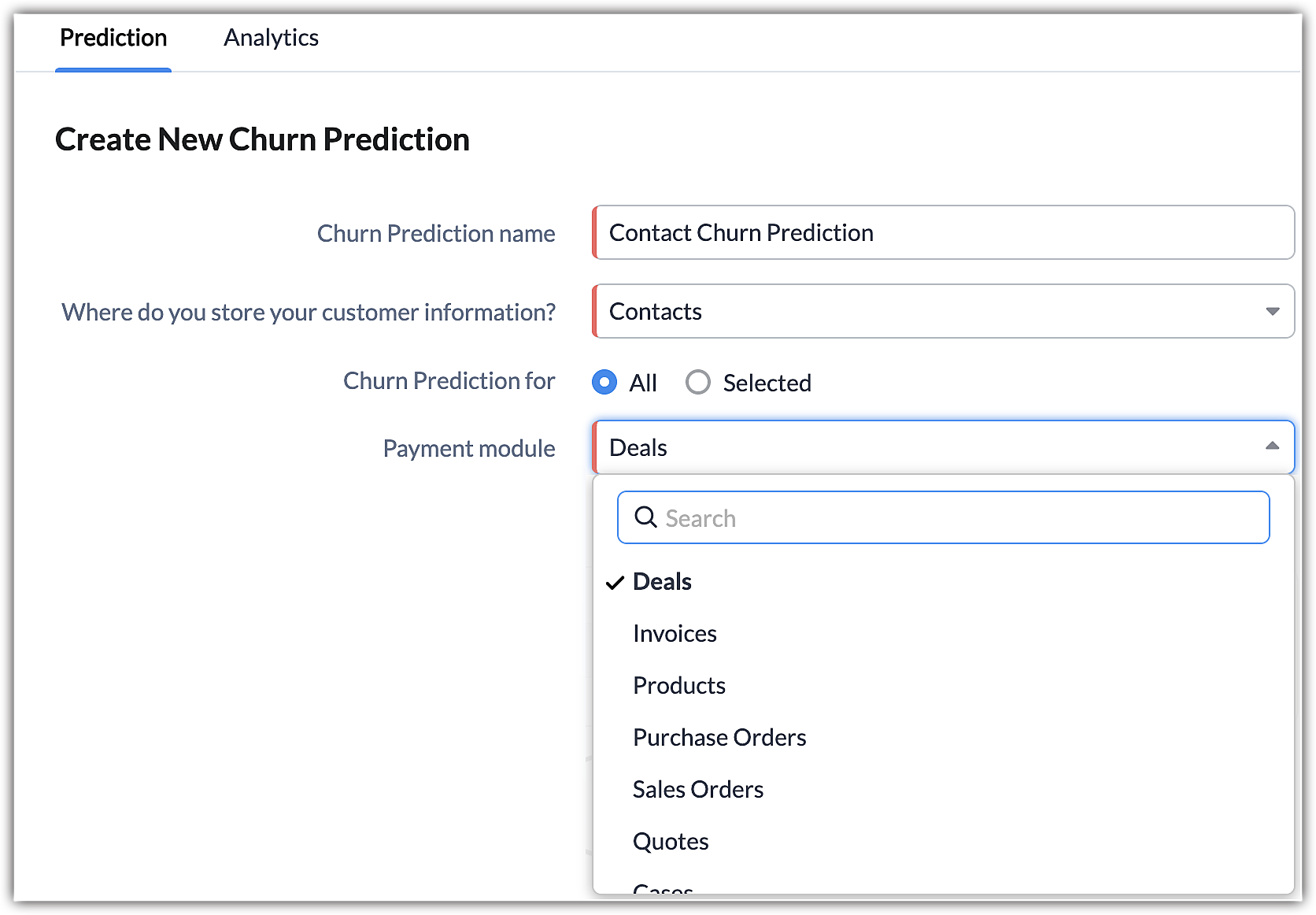
Step 3: Define successful payment criteria
Now that Zia knows who your customers are and where their payment information is, you have to show Zia what successful payment criteria look like. You're essentially training Zia to look for the expected behaviors of active customers.
For example: You can teach Zia that instances where the probability of a deal is 80% or above represent successful payments. These criteria act as reference points for classifying future customer records in the module.
- Specify the payment date : The payment date is any date field present in that module. You can use the starting date or closing date to indicate the payment schedule.
- Specify your business's revenue model: Based on your business offerings, you use either a recurrent or one-time payment revenue model. Zia needs to know this information in order to understand payment frequencies in your business.
- For a subscription-based revenue model , like a telecom provider, streaming service, or SaaS provider, the payment is expected to recur each month or each year. You can simply point to which field or module you're maintaining the information about the active subscription and Zia will observe the progress thereafter.
- For a non subscription-based payment model , like a purchase in an online store or FMCG transactions, Zia will refer to customers' previous transactions and payment frequencies to come up with churn predictions.
Step 4: Define customer churn for Zia
Just as you defined the traits of active customers above, Zia needs to understand what a churned customer would look like.
For example, you can instruct Zia to classify records below 50% of deal probability as a churning customer.
How to configure churn prediction
- Go to Setup > Zia > Prediction > Churn Prediction.
- If you're creating the churn configuration for the first time, click Get Started.
- To create a new churn configuration, click on the New Prediction button.
- In the Create New Churn Prediction page, do the following.
- Provide a unique name f or the prediction configuration.
- In the Where do you store your customer information? field, select a customer module.
- In the Churn prediction for option, select All if you want to predict for all records in your customer module.
- Select Selected if you want to predict churn only for specific records, and then provide the criteria.
- In the Payment module field, select the module where your customers' payment information is stored.
- In the Successful payment criteria field, enter the criteria that indicates a successful payment.
- Select the Payment date.
- In the Do your customers pay using a subscription-based revenue model? field,
- Select Yes if your payments are recurrent and choose the field where you store information about the subscription in the Active subscription field .
- Select No if your payments are occasional.
- In the How would you define customer churn? field, select the criteria that define churn.
- Click Save .
View the prediction detail page
After you've saved the prediction model, Zia will notify you if it has learned your configuration or not, and displays the summary of the configuration, additional information on the prediction, and its model accuracy.
Configuration summary
Zia will summarize how this churn prediction is configured. It will list all the criteria and fields used in the configuration for quick reference.
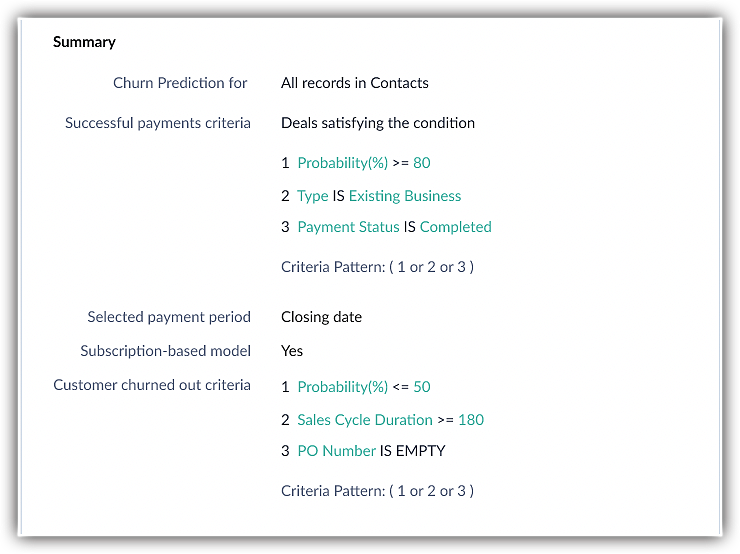
Additional information
For every prediction, based on the revenue model, Zia will create custom fields inside the record detail page. The information about the field created is listed under the Additional information section.
The score field is a numerical value. The prediction is a text field.
Model accuracy
Model accuracy is a self-examination Zia does to assess how well it managed to learn the prediction pattern and is an indicator of prediction quality. The higher the score, the higher the predictive accuracy is going to be.
The score is set on a scale of 1 to 100:
- Anything above 80 is a great score. It indicates that the prediction will be accurate.
- Score between 60-80 is considered moderate. While the prediction can be used to an extent, the predictions cannot be relied upon at all times.
- Any score below 60 is bad and Zia will conclude that the predictions are flawed.
To improve the model accuracy, Zia will retrain or relearn the pattern every two weeks.
Churn Usage Data
In addition to transactional data and usage data, Zia Churn can also integrate with data sources like Google Analytics. This integration enables Zia to analyze customer interactions with your services. Customers who already have churn predictions set up in the CRM will have the option to enable churn based on usage data.
Once the setup is complete and the necessary permissions are granted, Zia will use a combination of transactional and usage data to provide a more nuanced churn prediction. Additionally, robust error-handling measures are in place to ensure the integrity and accuracy of the data used.
To add usage data
- On the churn prediction detail page, click Add under Churn Usage Data.
- On the pop-up to pick a service.
You can select from Google Analytics and Mixpanel, and then click Next. - For Google Analytics, do the following on authorization page:
- Select the connection from the list of dropdown options.
- Provide the property ID.
In case you don't have your primary key, click here to learn more. - Select the Google Analytics field to link and synchronize with the customer field from the module in CRM.
Similarly, you can follow the steps for authorization with Mixpanel. - Click Authorize.

Notes:
- For Zia to learn and generate churn predictions, you need a minimum of 200 records per customer module, within which are at least 75 churned records and 75 active records.
- Zia will take up to 24 hours to analyze the data sets to come up with predictions.
- While there may not be any specific reason your model accuracy is low, you should ensure factors like null values, data duplication, multiple unique values that Zia cannot relate together, and so on, are addressed. You can amend validation rules, mark fields as unique to avoid data duplication, or auto-merge duplicates to prevent low scores.
- Once the configuration is saved, you can't edit the rule name, customer module, payment module, or revenue model. You can, however, edit the criteria mentioned in the configuration.
- The custom field will be created for all records, irrespective of whether the record contains predictions or not.
- In the case of Churn usage data, we've incorporated robust error-handling measures to ensure data integrity. If there are issues like the deletion of essential data components in Google Analytics, Zia will cease to use that data source, thereby maintaining the accuracy of the churn predictions.
- It's important to note that once a service like Google Analytics is selected and configured, the setup is final. Modifying or switching to a different service requires a new configuration.
Waiting for data
If you don't possess a sufficiently large data set yet, Zia will display the number of active customers and number of churned customers currently available in the customer module under the Waiting for data section. As mentioned above, Zia will need a minimum of 200 records to study and synthesize the prediction.
In addition to the churn configuration summary, the prediction's status can be obtained from Zia notification panel.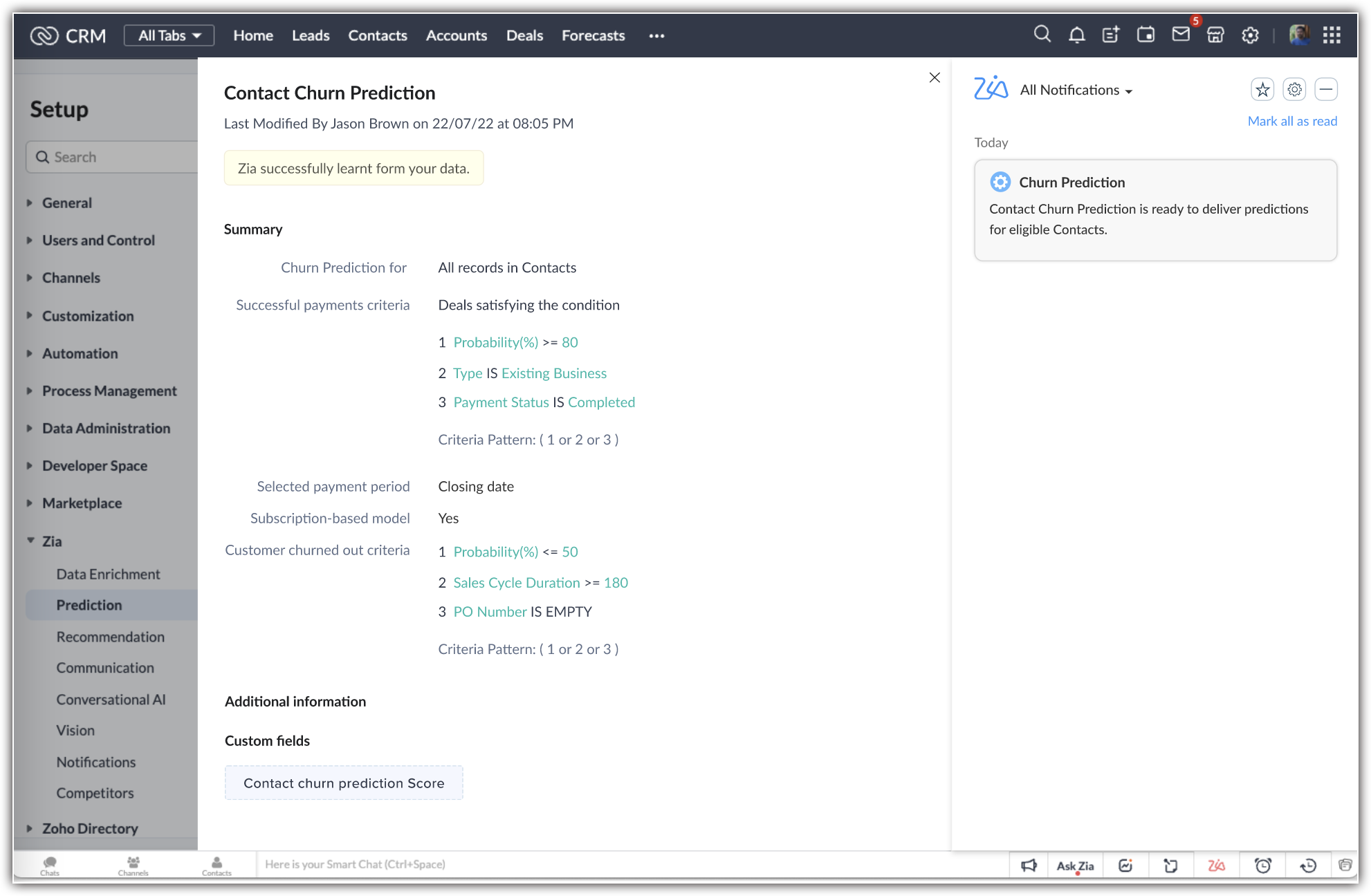
View churn predictions
As a key capability, Zia compares the configured behavior with customer behavior and classifies them as active customers or churned customers.
- If Zia predicts a potential churn, a widget will be displayed on the record details page of the qualified record, along with the name of the prediction rule and the churn probability score.
- If Zia predicts a customer is active, no predictions will be displayed.
As a result of churn prediction, Zia will also consume custom field limits and display two read-only fields on the record detail page for subscription-based revenue models. See also: Working with custom fields in Zoho CRM
- Churn score: The score displays the probability of that record to churn.
- Churn prediction: The prediction field displays the active subscription field associated with the customer record.
In the case of non subscription-based payment models, only the churn score will be displayed on the record detail page.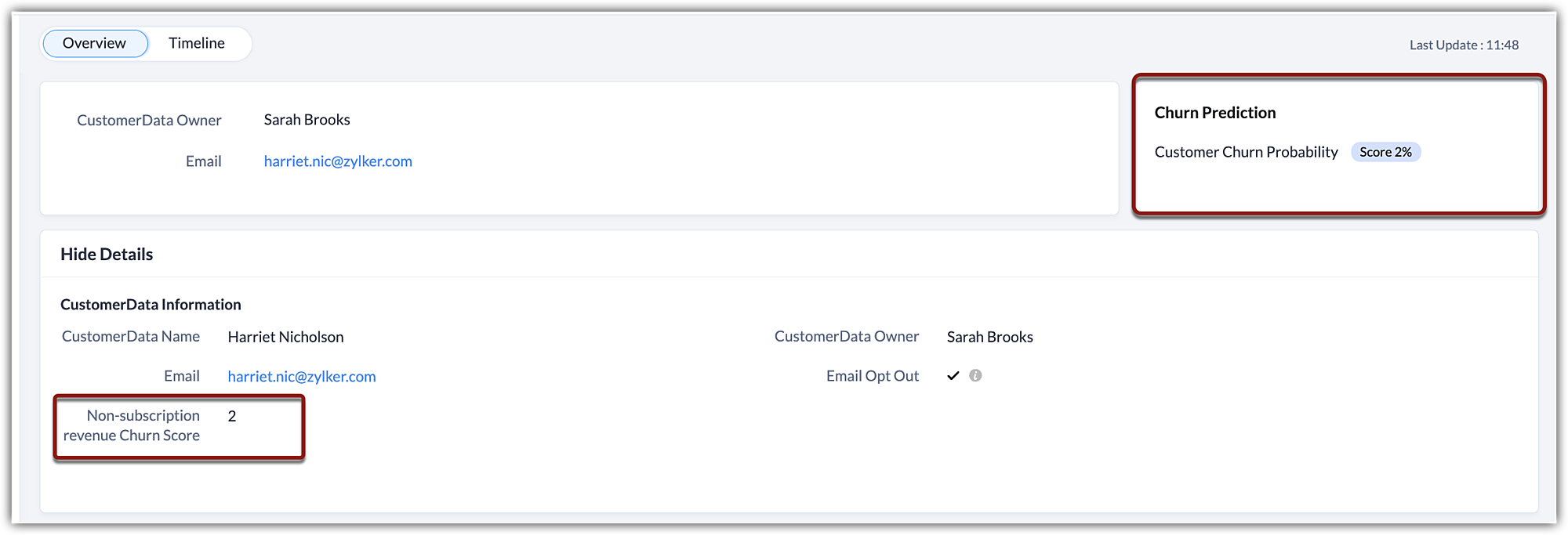
Interpreting churn score:
Churn score is the probability of the customer to churn out. The higher the score, the higher is the probability of the customer is going to churn out.

Notes:
- The number of churn fields created in a record depends on the number of churn configuration the record satisfies.
- The fields added to the record contain the same information as the prediction widget. However, in order to make further use of these findings in CRM—like generating reports, configuring automations, and sorting records using advanced filters—these fields will be useful.
Act upon Zia churn predictions in Zoho CRM
Churn prediction is an indicator of your business performance. You can use the field value of predicted score and product across CRM to perform different actions and derive different insights. Let's look at a few of them.
- In Workflow rules, you can use the score field as a criteria and automate actions like create tasks, add tags, notify record owners, etc.
- In Reports, where you can collate all the churn customers as a table and observe the pattern of churn score among customers.
- In Module views and advanced filters, to sort churning customers from the rest of the customer base and tend to them with more attention.
Zoho CRM Training Programs
Learn how to use the best tools for sales force automation and better customer engagement from Zoho's implementation specialists.
Zoho DataPrep Personalized Demo
If you'd like a personalized walk-through of our data preparation tool, please request a demo and we'll be happy to show you how to get the best out of Zoho DataPrep.
New to Zoho Writer?
You are currently viewing the help pages of Qntrl’s earlier version. Click here to view our latest version—Qntrl 3.0's help articles.
Zoho Sheet Resources
Zoho Forms Resources
New to Zoho Sign?
Zoho Sign Resources
New to Zoho TeamInbox?
Zoho TeamInbox Resources
New to Zoho ZeptoMail?
New to Zoho Workerly?
New to Zoho Recruit?
New to Zoho CRM?
New to Zoho Projects?
New to Zoho Sprints?
New to Zoho Assist?
New to Bigin?
Related Articles
Capabilities of Zia in Zoho CRM— A perspective
Zoho CRM harnesses the transformative power of Artificial Intelligence (AI) to revolutionise decision-making across all critical areas of your business, from initial customer interactions to their entire journey. With Zia, AI-powered assistant, Zoho ...Zia Notifications
Staying ahead of all the latest updates that come in from different resources is crucial for any business. If you have been using Zia to gain meaningful insights to improve your sales, then you might also want to take advantage of its notifications ...Zia Field Prediction
Zia's field prediction builder is a toolkit for CRM administrators to build custom predictions in their business. This simple and intuitive builder can quickly predict probable outcomes for both standard and custom modules. What can you predict? You ...Prediction Analytics
Zia can understand business metrics, analyze them, and predict the possible outcome that can help in decision-making and preparing your business for the future. To substantiate the prediction results, Zia shows the analytics that were taken into ...Zia - Next Best Experience
Overview In today’s competitive market, every customer interaction is an opportunity to build lasting relationships and drive growth. Zia’s Next Best Experience (NBX) transforms raw CRM data into actionable insights—enabling your team to nurture ...
New to Zoho LandingPage?
Zoho LandingPage Resources















